The Mugello Region - Handicrafts and Manufacturing Activity

Land with a wealth of handicrafts traditions, Mugello occupies the upper and middle course of the Sieve River. Since the medieval epoch, the villages born under the influence of the Florentine Republic performed the function of marketplace, distributing local products, fruit of the area’s farming and manufacturing activity. This itinerary offers the possibility to rediscover the region’s old trades, such as working pietra serena, and the art of knife-making in Scarperia.
The first leg of the journey is some 40 km from Florence. Take SS65 proceeding north and, after passing Pratolino and Vaglia, near San Piero a Sieve turn onto SP551/SS551 and continue on towards Borgo San Lorenzo. In the locality of Torre, take SP42 and proceed to Luco Mugello where you can visit the Museo della Civiltą Contadina, housed in a former farmhouse which, with its collection of tools and reconstructions of rooms, offers an interesting panorama of the area’s old activities.
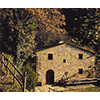
The Museum forms part of the Decentralised Museum of Mugello - Upper Mugello - Val di Sieve. It was founded around 1983 at the initiative of the Erci Group, an association of volunteers constituted in 1976, with the support of the population and the local administrations. For many years it has engaged in research on rural culture, organising various initiatives, many of which have been reported in the Group's own publications.
The Museum is situated in an old country house, perfectly restored, on the banks of the Erci torrent. The 24 sections of the exhibition display over 2,000 tools, objects and documents bearing witness to the rural life of the peasant civilisation in Upper Mugello, with its characteristic activities of farming, work in the forest and charcoal production.
Outside of the Museum, an interesting Naturalist-Historical Path illustrates the changes that have taken place in the local culture and landscape. It also features replicas of the various stages of work in the forest, including charcoal burning, the system used to turn wood into charcoal. To make charcoal, wood was heaped in a pile in a clearing, then covered with packed-down earth and lighted on the inside, out of contact with the air.
There is also a botanical garden with high-truck trees and shrubs (perennially woody plants) as well as low-trunk trees branching close to the ground, characteristic of the forests covering the Tuscan-Romagnolo Apennines.
(Anna Toscano)
Following Via Gino Innocenti for 2 kilometres, you reach Grezzano, where the premises of the Faini Mill still house the old machinery tied to its century-old activity.
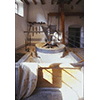
Located in Borgo di Grezzano, the mill dates at least to 1588 as property of the Pieroni family of Florence. In 1642, it became property of the Santa Maria Nuova Hospital of Florence, and in 1780 become property of the Faini family which kept it operating until 1988, when it decided to open it to the public, resuming the production of flour to illustrate the age-old techniques. Since 2002, it is part of the Mugello - Upper Mugello - Val di Sieve Diffused Museum.
Inside the old mill, restored in 2001, are the original machinery and equipment (datable from the 18th to the 20th century) used on site during the mill’s activity, including a water turbine, a millstone, sifters, sieves, scales and more. The machinery and equipment are in their original locations.
(Donato Monaco)
Backtracking for 5 kilometres and turning towards Scarperia, you can stop to visit the Museo dei Ferri Taglienti that illustrates the centuries-old tradition of the town’s knife-makers, whose activity was spawned by that of the region’s gunsmiths.
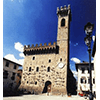
Founded in 1999 and housed in the fourteenth-century Palazzo dei Vicari, the Museum documents the culture and production of knives, typical of the town of Scarperia. The life and work of the families of knife makers are presented by exhibiting objects, images and reconstructions of interiors. Inside the Museum, a knife maker’s workshop has been reconstructed where demonstrations and educational activities are conducted.
The collection comprises knives and other cutting instruments made in Italy (Scarperia in particular) and tools for their production. The exhibits can be dated from antiquity to the present day, and illustrate the evolution of techniques, particularly as concerns the Scarperia production.
Part of the Mugello - Upper Mugello - Val di Sieve Diffused Museum, the Museum is managed from the scientific viewpoint by the Research and Documentation Centre on Handmade Cutting Implements, formed in 1987 by initiative of the Town Administration of Scarperia.
In addition to housing the Museum of Cutting Implements, the Palazzo dei Vicari of Scarperia also presents a rare and fascinating technical-scientific object: a little room on the upper floor exhibits the clockwork of the building’s tower clock which seems to have been made by Filippo Brunelleschi.
(Anna Toscano)
The itinerary can conclude in Firenzuola, located 20 km away on SS503, where you will find the Museo della Pietra Serena which documents the art of the master stonemasons who, especially in the Upper Mugello, owe their origin to the territory’s abundance of arenaceous stone.
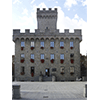
Founded on December 19, 1999, the Museum is housed in the basement of the Fortress of Firenzuola (Town Hall headquarters), built in the late 15th century on a plan by Antonio da Sangallo. It documents the techniques of extraction and working pietra serena by means of exhibiting locally produced artefacts, utensils (chisels, anvils, whetting stones, wedges and other stonemasons’ and quarrymen’s tools) and works of art tied to the town of Firenzuola. The quarries of "Firenzuola stone" are sited in the mountains east of Piancaldoli and in the valleys of the Santerno stream (tributary of the Reno) and Rovigo stream (tributary of the Santerno). The Museum of Pietra Serena of Firenzuola is part of the Mugello - Upper Mugello - Val di Sieve Diffused Museum.
(Graziano Magrini)
The visitor interested in the region’s culture can also visit the Museum housed in the Palazzo dei Capitani of Palazzuolo del Senio, continuing another 30 km on SS610, SS32 and SS306.
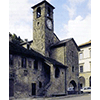
Inaugurated in 1982 and housed in the fourteenth-century Palazzo dei Capitani, the Museum forms part of the Mugello – Upper Mugello - Val di Sieve Decentralised Museum.
The collection, containing over a thousand objects resulting from thirty years of research by local volunteers, includes utensils, instruments and machinery typical of life and work in the mountains, such as charcoal-burners' apparatus, tools for work in the woods and the fields, and implements from mills. The objects date from a period ranging from the 17th to the 20th century.
(Anna Toscano)
****************************
Texts by Elena Fani
English translation by Victor Beard
Last update 21/feb/2008



 = libraries and archives
= libraries and archives  = scientific research centers
= scientific research centers  = memorial places of scientists
= memorial places of scientists = public health places
= public health places = places of science and worship
= places of science and worship = places of technology
= places of technology  = museums and collections
= museums and collections  = villas and gardens of science
= villas and gardens of science

